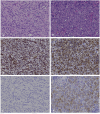Mediastinal Fibrosarcoma in a Dog-Case Report
- PMID: 35224085
- PMCID: PMC8863873
- DOI: 10.3389/fvets.2022.820956
Mediastinal Fibrosarcoma in a Dog-Case Report
Abstract
This represents the first published case report of mediastinal fibrosarcoma in a dog. An 8-year-old male neutered mixed breed dog was presented for evaluation of lethargy and increased panting. Thoracic focused assessment with sonography for trauma revealed moderate pleural effusion. Thoracic radiograph findings were suggestive of a cranial mediastinal mass. Computed tomography revealed a mass within the right ventral aspect of the cranial mediastinum. On surgical exploration, a cranial mediastinal mass with an adhesion to the right cranial lung lobe was identified and removed en-bloc using a vessel sealant device and requiring a partial lung lobectomy. Histopathology results described the cranial mediastinal mass as fibrosarcoma with reactive mesothelial cells identified within the sternal lymph node. The patient was treated with systemic chemotherapy following surgical removal. To date, the dog has survived 223 days following diagnosis with recurrence noted 161 days following diagnosis and radiation therapy was initiated. Primary cranial mediastinal fibrosarcoma while a seemingly rare cause of thoracic pathology in dogs, should be considered in the differential diagnosis for a cranial mediastinal mass.
Keywords: blunt dissection; case report; chemotherapy; dog; doxorubicin; fibrosarcoma; mediastinum; surgery.
Copyright © 2022 McGrath, Salyer, Seelmann, Lundberg, Leonard, Lorbach, Lumbrezer-Johnson, Hostnik, Tremolada, Lapsley and Selmic.
Conflict of interest statement
The authors declare that the research was conducted in the absence of any commercial or financial relationships that could be construed as a potential conflict of interest.
Figures


References
Publication types
LinkOut - more resources
Full Text Sources
Research Materials

